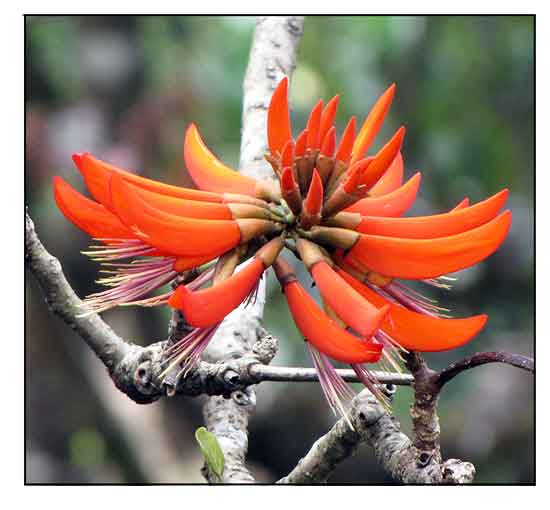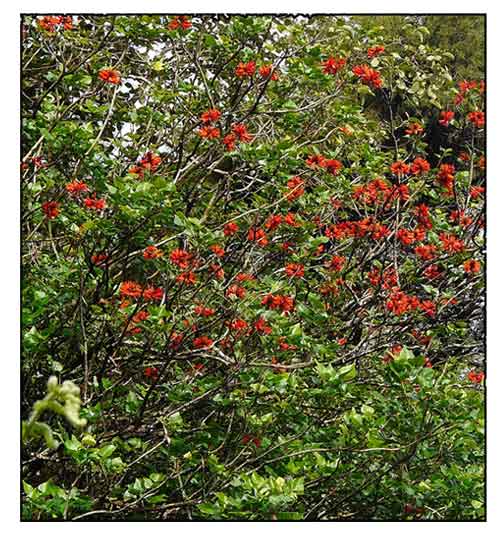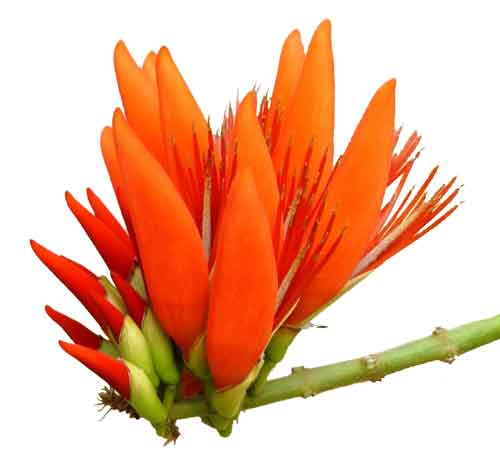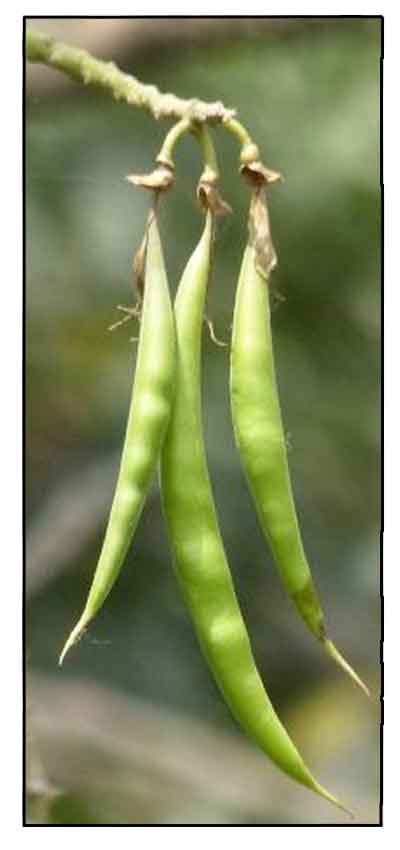 Gen info Gen info
- Erythrina is a genus of plants in the pea family, Fabaceae, containing about 130 species distributed in tropical and subtropical regions worldwide.
-
Erythrina stricta is a species of trees in the family Fabaceae identified by William Roxburgh in 1832. (3)
- Etymology: The genus name Erythrina derives from the Greek word erythros, meaning "red", referring to the flower color of certain species. (4)
- Color snippets: There is striking color polymorphisms. Color variations include orange, yellow, salmon, green, and while, all within natural populations. Many species have bright red flowers. Other popular names, liken the flower's red hues to those of the male chicken's wattles, and/or the flower shape to its leg spurs.
Botany
• Trees, 7-12 m tall. Trunk straight. Branches with short whitish prickles. Leaves pinnately 3-foliolate; stipules deciduous; petiole 12-15 cm, rarely with prickles; terminal leaflet broadly triangular, almost rhomboid, or broadly reniform-oblate, 7-19 × 7-24.5 cm, both surfaces glabrous, lateral veins 5-8 pairs, base nearly cordate, truncate, or broadly cuneate, margin entire, apex acute or caudate with mucro 10-15 mm. Raceme ca. 15 cm, flowers in clusters of 3 or 4. Calyx spathelike, undivided or apex slightly 2-lobed. Corolla red; standard elliptic-lanceolate or ovate-triangular, erect, 3-4.5 cm, subsessile; wings subobovate, 6-8 mm, shorter than calyx; keels much longer than wings. Ovary hairy, stipitate; style narrow, glabrous. Legume 7-12 × 0.7-1.5 cm, glabrous. Seeds 1-3 or more, light or dark brown, reniform. (Flora of China)
Distribution
- Native to the Philippines. (1)
- Also native to Assam, Bangladesh, Cambodia, China South-Central, China Southeast, East Himalaya, India, Laccadive Is., Laos, Myanmar, Nepal, Thailand, Tibet, Vietnam, West Himalaya. (2)
 Constituents Constituents
- Study of stem bark isolated four previously undescribed erythrinan alkaloids, 8α-acetonylerythristemine, 8α-acetonylerysotrine, 10β-hydroxy-11β-methoxyerysotramidine and 3-epierysotrine, one undescribed pyrrolidine derivative, S-1-(4-hydroxy-3-methoxyphenethyl)-5-hydroxy pyrrolidin-2-one, and one undescribed amide, N-(3-hydroxy-4-methoxyphenethyl)-4-hydroxylbutanamide, along with thirteen known alkaloids. (5)
- GC-MS analysis of n-hexane extract of stem bark yielded antibacterial and antifungal compounds ß-caryophyllene,
α-selinene, ß-selinene, selin-11-en-4-α-ol, α-copaene and δ -cadenine. (6)
- Study of DCM extract of stem bark isolated a novel compound erynone (1), together with six known compounds, wighteone (2), alpinum isoflavone (3), luteone (4), obovatin (5), erythrinassinate B (6), and isovanillin (7). (see study below) (6)
-
Study evaluated proximate and mineral composition of E. stricta seeds. The seeds exhibited commendable proximate composition of protein (26.81%) and fiber (18.71%). Mineral elements included 5.0 mg/g DW of calcium and 787.0, 32.7, 36.8, and 497.0 µg/g iron, copper, boron, and zinc, respectively. Seeds yielded 13.43$ oil, with oleic, palmitic, linoleic, and stearic acids as  prominent fatty acids, constituting 48.82%, 20.63%, 20.27%, and 6.47%, respectively. Antinutrients oxalate and phytate were present at26.85 and 16.04 mg/g FW, respectively. (7) prominent fatty acids, constituting 48.82%, 20.63%, 20.27%, and 6.47%, respectively. Antinutrients oxalate and phytate were present at26.85 and 16.04 mg/g FW, respectively. (7)
- Study of n-hexane extract of stem bark isolated an alpinum isoflavone. (10)
- Phytochemical screening of leaves y9ielded tannins, flavonoids, alkaloids, and terpenoids. (see study below) (10)
- Study of flowers isolated a new alkaloid: 11-acetyl erysotrine. (13)
- Study of petroleum ether extract of bark yielded alkaloids, flavonoids, phenols, tannins, amino acids and proteins, phytosterols and triterpenoids. Total phenolic content was 3.77 mg gallic acid equivalent per gram (GAE/g), total flavonoid content was 7.75 mg quercetin equivalent per gram (QE/g) of dry extract. (18)
- Study of stems and leaves isolated 23 alkaloids, one of them previously unreported, 11-ß-hydroxy-erythratidine N-oxide. (19)
Properties
- Studies have suggested antioxidant, antimicrobial, nutrient, cardioprotective, antigout, hypouricemic, anticataract, xanthine oxidase inhibitory, antiurolithiatic, hepatoprotective properties.
Parts used
Leaves, bark, flowers.
 Uses Uses
Edibility
- No studies or reports found on edibility.
Folkloric
- No reported folkloric medicinal use in the Philippines.
- In Indian indigenous systems, bark used for treatment of rheumatism, stomachaches, asthma, dysentery, contact dermatitis, eczema, and skin infections. (6)
- In India, bark used for treatment of
epilepsy and leprosy. Stems used as spasmolytic, hypothermic, diuretic, anticonvulsant, analgesic, antiviral, antifungal, and anti-protozoa. (15)
- Among the Mizo people of India, used for treatment of stomach ulcers, diabetic blisters, intestinal roundworm infection, skin infection, sores, and wounds. (18)
- Leaves used to alleviate joint pains, earache, toothache, and eye infections Bark used for treating asthma, epilepsy, rheumatism, itch, stomachache, and dysentery. Bark paste applied to eczema and dermatitis. (7)
- Bark and flower used for biliousness, rheumatism, asthma, leprosy, epilepsy, fever, and as antidote to poison. (22)
Others
- Agroforestry: In Thailand, tree is used in reforestation projects to restore native woodland. In India, it is cultivated as a hedge plant, in living fences, and for supporting pepper and vine. (23)
- Dye: Bright red flowers yield a color used in dyes. (23)
- Wood: Used for making household utensils.
Studies
• Antimicrobial / Antioxidant / Stem Bark: Study evaluated the antimicrobial and antioxidant activity of stem bark of E. stricta to support its topical use in treatment of contact dermatitis, eczema, and skin infections. A dichloromethane, ethyl acetate, and n-hexane extracts showed most significant activity with MICs of 7.8, 125, and 125 µg/mL against a sensitive strain of Staphylococcus aureus. The DCM and EA extracts also showed significant activity against Candida albicans with MICs of 125 and 1 mg/mL, respectively. Luteone (compound 4), isolated from DCM extract exhibited most significant antibacterial activity with MIQs (minimum inhibitory quantity) of 1.88, 1.88, and 3.75 µg, respectively, against sensitive (MSSA) and resistant strains (MRSA and MDRSA) of S. aureus. Erynone (1) exhibited greatest DPPH free radical scavenging activity. Results support the use of E. stricta bark for treatment of skin and wound infections. (see constituents above) (6)
• Seed as Potential Source of Functional Foods / Seeds: Study evaluated the nutritional quality, proximate and mineral composition of E. stricta seeds, with focus on characterizing the seed oil. The seeds yielded commendable proximate composition for protein and fiber. Mineral elements included calcium, iron, copper, boron, and zinc. Seeds yielded 13.43% oil, with oleic, palmitic, linoleic, and stearic acids as prominent fatty acids. Results underscores the seeds as a robust source of both nutrients and oil, warranting further studies for potential applications. (see constituents above) (7)
• Anticataract / Leaves: Study evaluated the anti-cataract activity of E. stricta leaves against naphthalene-induced cataractogenesis in Wistar albino rats. Various leaf fractions were administered orally simultaneously with naphthalene (1g/kg) for 28 days. Ophthalmoscopic observation indicated simultaneous administration of extract fractions delayed the onset and maturation of cataract. All fractions (except residual fraction) prevented peroxidative damage caused by naphthalene. Activity was attributed to antioxidant activity. (8) (21)
• Cardioprotective / Leaves: Study evaluated the cardioprotective activity of E. stricta leaves against isoproterenol induced myocardial infarction in Wistar albino rats. Cardioprotective was assessed by estimating activities of serum aminotransferase, LDH and CK. Animals treated with E. stricta leaf extract showed decrease in serum enzyme levels and increase in antioxidant status. Results suggest cardioprotective activity of leaf extract. (8)
• Antioxidant / Leaves: Study evaluated a 70% ethanol extract of leaves for antioxidant activity using invitro antioxidant assays including NO scavenging, superoxide anion scavenging, reducing ability, hydroxyl radical, H2)2 scavenging, total phenolic and total flavonoid contents, metal chelating, carotene-bleaching, total peroxy radical assays among others. In all methods, the extract exhibited strong antioxidant activity in a concentration dependent manner. The extract did not exhibited any prooxidant activity. Results indicate E. stricta scavenges free radicals and reduces lipid peroxidation, ameliorates damage imposed by oxidative stress and serves as potential source of natural antioxidant. (9)
• Hypouricemic Activity / Anti-Gout Activity / Leaves: Study evaluated the invivo hypouricemic activity of various fractions of hydromethanolic extract of E. stricta leaves using oxonate-induced hyperuricemic rats. Allopurinol was used as positive control. Petroleum ether, chloroform, and ethyl acetate fractions produced a significant reduction in serum urate levels. The fractions also elicit significant inhibitory actions on the XO/XDH enzyme activities in mouse liver. The hypouricemic activity may be due to inhibition of XO/XDH enzymes. The effect of the fractions was less potent than allopurinol. The phytoconstituents may be partly responsible for the beneficial effect of the fractions on hyperuricemia and gout. (11)
• Cytotoxicity Against A549 Cell Line / Bark: Study evaluated the invitro cytotoxicity of methanol (ESM) and chloroform (ESC) extracts of E. stricta bark against A549 cell lines (lung cancer). MTT assay for cytotoxicity were done against standard doxorubicin and IC50 concentrations. Cytotoxicity study suggest the extracts reduced viable cells by exerting a cytotoxic effect. (12)
• Anti-Inflammatory / Leaves: Study evaluated an ethanol extract of E. stricta leaves for anti-inflammatory activity in albino rats using acute carrageenan paw edema, formalin induced paw edema, and subacute granuloma pouch model. A dose of 200 mg/kg was found to be more potent and efficacious towards anti-inflammatory activity when compared with control. Activity was dose-dependent. Results showed anti-inflammatory activity in acute and sub-acute administration in albino rats. Anti-inflammatory activity was attributed to inhibition of synthesis, release or action of inflammatory mediators viz., histamine, serotonin, and prostaglandin that might be involved with inflammation. The anti-edematogenic effect on carrageenan and formalin induced edema may be due to inhibition of inflammation mediator formation. (14)
• Xanthine Oxidase Inhibitory / Leaves: Study evaluated the invitro xanthine oxidase inhibitory activity of various fractions of hydromethanolic extracts of E. stricta leaves and its enzyme inhibition mechanism. Among fractions tested, the chloroform extract exhibited highest potency (IC50 21.2 microg/ml) followed by pet-ether (30.2), ethyl acetate (44.9) fractions. IC50 of standard allopurinol was 6.1 microg/ml. Enzyme inhibition mechanisms was of the mixed type. The antigout effect could be attributed to its xanthine oxidase inhibitory activity. (16)
• Antioxidant / Antibacterial / Bark: Petroleum ether extract of bark showed concentration dependent activity against DPPH, with IC50 of 3.33 mg/ml, compared to reference butylated hydroxytoluene at 0.23 mg/ml. Total antioxidant capacity was 12.01 mg ascorbic acid equivalent per gram (AAE/g) of dry extract. Total phenolic content was 3.77 mg gallic acid equivalent per gram (GAE/g), total flavonoid content was 7.75 mg quercetin equivalent per gram (QE/g) of dry extract. Extract effectively inhibited Gram(+) bacteria, Bacillus cereus and Staphylococcus aureus, and Gram(-) Klebsiella pneumoniae. Results showed high antioxidant values and species-specific antibacterial activities. (see constituents above) (18)
• Hepatoprotective / CCl4-Induced Hepatotoxicity / Leaves: Study evaluated the hepatoprotective activity of ethanolic extract of leaves of E. stricta and Vitex negundo against carbon tetrachloride-induced hepatotoxicity in rats. Oral administration of the extracts at dose of 200 mg/kbw simultaneously with CCl4 for 7 days resulted in a significant (p<0.01) reduction in serum marker enzymes and liver MDA and a significant (p<0.01) improved in antioxidant activity when compared to CCl4 damaged rats. Histopathological studies further evidenced hepatoprotective activity. Activity was almost comparable to the silymarin-treated group. Hepatoprotective activity was attributed to its antioxidant potential. (20)
• Antiurolithiatic Activity / Aerial Parts: Study evaluated the anti-urolithiatic activity of aerial parts of E. stricta using a calculi-producing diet model. Calcium oxalate nephrolithiasis was induced by injecting sodium oxalate for 7 days. Oral administration of 70% ethanol extract (500 mg/kbw/day) and ethyl acetate fraction (200 mg/kbw/day) along with sodium oxalate in treated groups, showed significant dose dependent restoration of all altered serum and homogenate enzymatic parameters. Histologic evaluation showed strong inhibition of calculi growth within the tubule and reduced necrosis of tubular epithelial cell. Results suggest anti-urolithiatic activity evidenced by inhibitory effect on crystal growth and improvement in kidney function and architecture. (8)
Availability
- Wild-crafted.
- Seeds, plants in the cybermarket.
|

![]()







